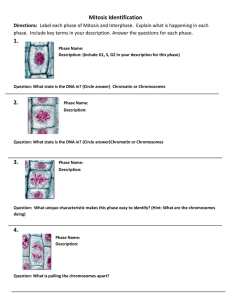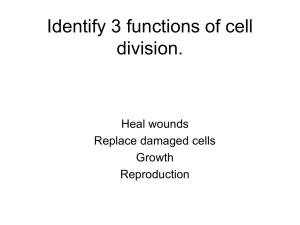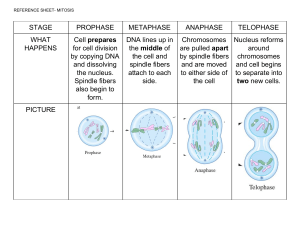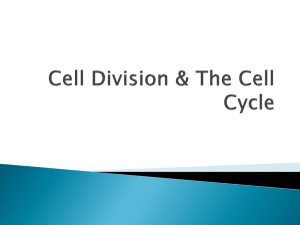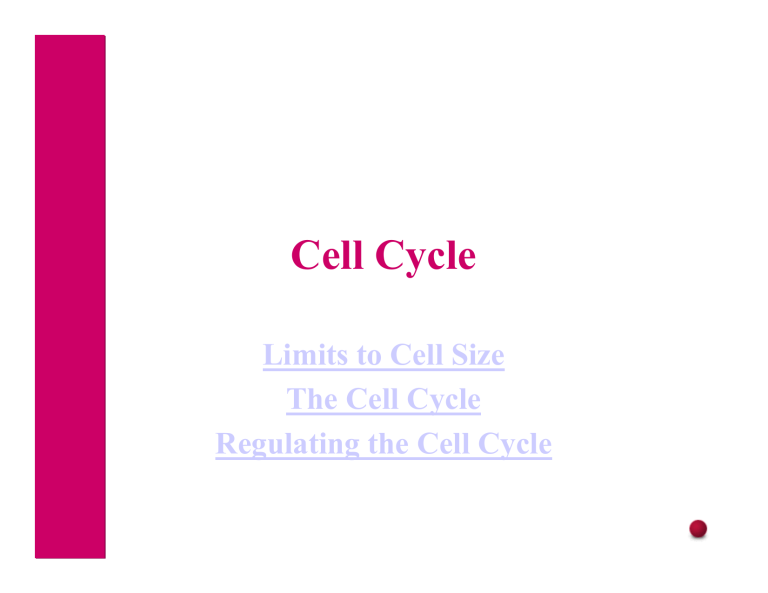
Cell Cycle Limits to Cell Size The Cell Cycle Regulating the Cell Cycle Limits to cell size Why are cells so small? What advantage is there to keep lots of small cells rather than have one large cell? • Specialization • Protection and resistance to damage • Efficiency (surface area:volume ratio) Ratio of Surface Area to Volume in Cells Cell Size Surface Area (length x width x 6) Volume (length x width x height) Ratio of Surface Area to Volume • How far will food particles be able to diffuse into each cell? • What factors effect transfer of material into/out of the cell? • How is this used in the human body? Johnson Exploration: Cell Size • Cell Maintenance – The work of cells is done by proteins. As a cell gets larger, more proteins are required to maintain its function. – If the cell gets too large, DNA instructions cannot be copied quickly enough to make the proteins that the cell needs to support itself. – Cell size is also limited by the cell’s DNA. • Exchanging Materials (surface area:volume ratio) – Oxygen, food, water and wastes all pass through the cell membrane. – How fast these can enter and exit depend on the external surface area. – How fast the cell uses food and oxygen depends on the internal volume. Summary • The larger the cell becomes, the more demands the cell places on its DNA (DNA overload) and the more trouble the cell has moving enough nutrients and wastes across the cell membrane (surface area:volume ratio). • Solution: Small cells Cell Cycle Problem solving: How important is the fist cell division. Reproduction Importance link Asexual- 1 parent Sexual- 2 parents Exploring Life CD • Each time a cell reproduces, it divides into two new cells. When each of the new cells divide, the result is four new cells. If this continues, how many cells will be present after the cells reproduce 6 times? Binary Fission bacteria • Bacteria, cyanobacteria, and most single celled organisms reproduce by binary fission. fission DNA cell membrane M I T O S I S • Duplication of a eukaryotic somatic cell. • Somatic Cell- body cell ex. Skin, liver etc. Does not include: sperm or egg. • All Somatic cells have the same number of chromosomes. Liver Cell Liver Cell 2n=46 2n=46 2n=46 Results: two identical daughter cells Liver Cell C E L L Interphase Normal cell activities Mitosis Division of chromosomes Cytokinesis Division of cytoplasm Cell cycle animation G1 phase Interphase S phase G2 phase Prophase C Y C L E G1 phase Metaphase Mitosis Anaphase S phase Telophase G2 phase Cytokinesis I N • Comprises about 90% of the cell life cycle. T • What takes place at this time? E 1. Cellular growth R 2. protein synthesis 3. metabolic activities P 4. DNA replication (synthesis) H Normal Cell activities A S E I N T E R P H A S E 1. G1 (gap) phase: – Growth, protein synthesis and metabolic activities. (normal activities) G phase – most cell exist in this phase. phase 1 2. S (synthesis) phase: – DNA replication S phase G2 phase 3. G2 (gap) phase: – Cellular growth and preparation for Mitosis. Mitosis Problem Solving- how does the cell cycle vary? Interphase • Nucleus and nucleolus visible. chromatin Nuclear Envelope cell membrane nucleolus Question: • What is a chromosome vs. chromatin? • Chromosome is made up of a DNA - histone protein complex. Chromosomes have their own centromere. • Chromatin is a long, thin DNA fiber before it is coiled into a chromosome. Nucleosome Chromosome Centromere DNA double helix Coils Supercoils Histones What is a replicated chromosome? • A replicated chromosome consist of two strands of identical DNA called chromatids (sister chromatids) chromatids held together by a centromere. chromosome S phase: chromosomes replicate chromatid chromosome chromatid centromere • When is a chromatid a chromatid? Answer: • A chromatid is a chromatid as long as it is held in association with a sister chromatid at the centromere. centromere centromere chromatid chromosome chromatid chromosome P R O P H A S E Longest phase of mitosis • Centrioles move apart (not found in plants) • Spindle fibers form and attach to centromeres • Nuclear envelope breaks down, nucleolus disappears C B F E Mitosis: Interactive Java Tutorial Click to animate the image. D A Prophase early prophase late prophase centrioles spindle fibers aster fibers nuclear envelope disappearing centromere Question: • What attaches the spindle fibers to the centromeres? Answer: Kinetochores aster fibers centromere centriole spindle fiber sister chromatid kinetochores sister chromatid M E T A P H A S E • Shortest phase • Centrioles travel to the poles of the cell and anchor with aster fibers. fibers • Chromosomes move to the metaphase plate (equatorial plate center of cell). Aster fibers Spindle fibers Metaphase plate Metaphase centrioles aster fibers spindle fibers metaphase plate A N A P H A S E Problem solving: How does a chromosome move. Centromeres separate and spindle fibers contract. Sister chromatids separate and move apart. After separation, chromatids are now considered chromosomes. chromosomes A N A P H A S E Anaphase No longer sister chromatids, chromatids now chromosomes aster fibers spindle fibers centrioles A N A P H A S E T E L O P H A S E • Nuclear membrane and nucleolus reappear. • Chromosomes uncoil to chromatin. • In the end, two genetically identical nuclei are present • Cleavage furrow develops in animal cells. Cell plate develops in plants. cell plate T E L O P H A S E nuclear membrane reforming nucleolus reappears cleavage furrow (cytokinesis) C Y T O K I N E S I S Cytokinesis- after Mitosis • Cytoplasmic division • Cell plate complete in plants • In the end, two separate daughter cells produced with single nucleus. cell plate What phase is show in each micrograph above? • If a plant cell undergoes mitosis, but no cell plate if formed, what would be the result? • Corn cells have 20 chromosomes. If it is dividing mitotically, how many chromosomes will be present at prophase, metaphase and anaphase? • A biologist studying corn roots (normally 20 chromosomes) locates one in late telophase with only 19 chromosomes. How might this have occurred? Knowing When to Start/Stop • Suppose you had a paper cut on your finger. Although the cut may have bled and stung a little, after a few days, it will have disappeared, and your finger would be as good as new. 1. How do you think the body repairs an injury, such as a cut on a finger? 2. How long do you think this repair process continues? 3. What do you think causes the cells to stop the repair process? PROBLEM SOLVING • Contact Inhibition A sample of cytoplasm is removed from a cell in mitosis. The sample is injected into a second cell in G2 of interphase. As a result, the second cell enters mitosis. Knowing when to stop • Phases • Check Points• What does G0 mean? • What does this mean for the cell? P R O B L E M S O L V I N G PROBLEM SOLVING Stem Cells • http://www.sumanasinc.com/webcontent/ animations/generalscience.html • http://www.dnalc.org/ddnalc/resources/st em_cells.html PROBLEM SOLVING Stem Cells- P R O B L E M S O L V I N G PROBLEM SOLVING PROBLEM SOLVING PROBLEM SOLVING
